#joro orb weaver
Text

Sharing the concept art for my Chryslestia family! Gonna have to snip a lot of HCs/notes so you can find the full thing over on my dA. Anyways, more info under the cut!
💙 Queen Celestia - Ruler of Equestria. Sun Deity. Royal Batpony Alicorn (With Heliacorn Attributes). Agender (She/he/it/they), Pansexual Demi
💙 Queen Chrysalis - Ruler of Equestria, Former Queen of the Changeling Hive. Reformed/Former Villain. Non-Reformed Queen Changeling. Nonbinary (It/xey/they/she), Bisexual Demi
💙 Princess Antlion Aphid - Princess of Equestria. Heir to the Sun. Solar Astronomer/Engineer. Has anxiety. Royal Alicorn-Changeling Hybrid (With Batpony/Heliacorn Attributes). 35 y/o. Nonbinary (It/its and She/her mainly), Lesbian. Likes studying the sun, sundresses, large hats, hosting parties, yoga, calligraphy and diplomacy. Aphie is based off of antlion larvae, not so much aphids but it's a cute lil addition to her name. Special talent is using the sun to power technology!
💙 Princex Hercules Metalmark - Princex of Equestria. Heir to the Sun. Armorer. Has autism. Royal Alicorn-Changeling Hybrid (With Batpony/Heliacorn Attributes). 35 y/o. Agender (They/them and xey/xem mainly), Trixic. Likes puzzles/cipher cracking, keeping fit, fruit, fire, sappy movies, giving gifts and winter. Inspired by the Hercules Beetle and the Metalmark Butterfly! Special talent is crafting enchanted armor!
💙 Prince Joro Orb Weaver - Prince of Equestria. Heir to the Sun. Seamster at Carousel Boutique. Royal Alicorn-Changeling Hybrid (With Batpony/Heliacorn Attributes). 35 y/o. Transmasculine/Nonbinary (He/him, It/Its, She/her), Bi. Likes designing outfits, spoken word poetry, spiral patterns, fantasy shows/books, posters, journaling and social events. Inspired by the Joro Spider and the common Yellow Garden Spider/Orb-Weaver! Special talent is sewing outfits!
💙 Princex Tsetse Deathwatch "Click" Beetle - Princex of Equestria. Heir to the Sun. Nurse. Gravedigger. Mute. Has autism. Royal Alicorn-Changeling Hybrid (With Batpony/Heliacorn Attributes). 35 y/o. Genderfluid (They/them and it/its mainly), Omni. Likes history documentaries, playing the guitar, baggy clothes, cemeteries, volunteering, birds and brownies. It was initially named "Princex Malachite" and based off of the Malachite butterfly, but since I've changed its' name it doesn't really resemble what its' currently named after: the Tsetse Fly and Click/Deathwatch Beetles. Special talent is healing creatures!
💙 Princess Venusta Orchard Mason - Princess of Equestria. Heir to the Sun. Gardener. Builder. Farmer. Royal Alicorn-Changeling Hybrid (With Batpony/Heliacorn Attributes). 35 y/o. Transfeminine/Nonbinary (They/them and She/her), Aro/Sapphic. Likes worms, pottery, lemonade, architecture, foraging, climbing trees, falling leaves and making friends. She's mainly inspired by the strikingly blue Orchard Mason Bee, which I first saw around my early high school years iirc and fell in love with it. The other half, Venusta, comes from the Venusta Orchard Spider! The 'Venusta' part of their name actually wasn't initially there, but I thought it'd be a pretty edition, especially since the two bugs share the word 'orchard' in their names. Special talent is building strong structures!
💙 Prince Rosy Maple Brimstone - Prince of Equestria. Heir to the Sun. Influencer. Disc Jockey. Party Thrower. Royal Alicorn-Changeling Hybrid (With Batpony/Heliacorn Attributes). 35 y/o. Intersex (He/him), Ace/Queer. Likes hyperpop/house music, makeup, bright colors, flea markets/antique malls, soap carving, blogging and raves. Rosy is mainly based on the Rosy Maple Moth, but the other part of his name comes from the Brimstone Butterfly! Special talent is DJing and music production!
💙 Prince Atlas Adonis Blue - Prince of Equestria. Heir to the Sun. Drag Queen. Royal Alicorn-Changeling Hybrid (With Batpony/Heliacorn Attributes). 35 y/o. Demiboy (He/him and They/them), Gay. Likes singing, the stars, glowsticks, finance, karaoke, collecting mugs, clubbing, glitter and cleaning. Atlas is of course inspired by the Atlas Beetle and the Adonis Blue Butterfly! Special talent is performing!
#venomverse#oresteiaverse#mlp#nextgen#fanchild#mlp nextgen#venomdraws#my little pony#mlp fim#chryslestia#princess celestia#queen chrysalis#antlion aphid#hercules metalmark#joro orb weaver#tsetse deathwatch 'click' beetle#venusta orchard mason#rosy maple brimstone#atlas adonis blue
25 notes
·
View notes
Text
help me decide which scry I should dedicate my joro spider breeding project to!
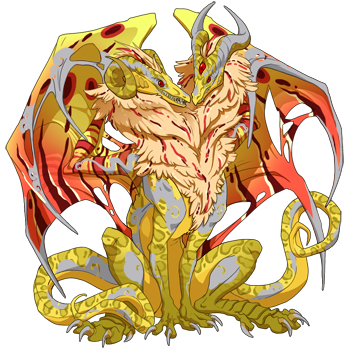

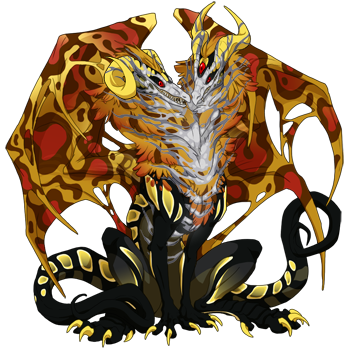

he's meant to look like one of these guys:
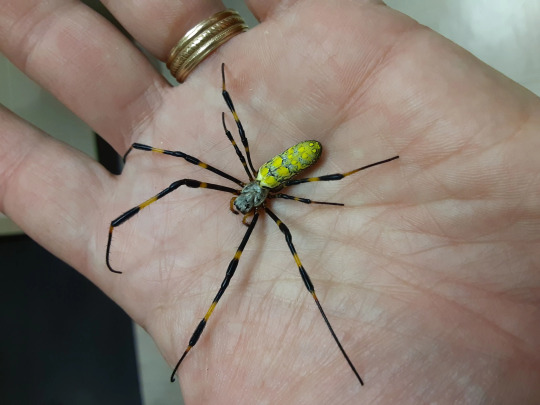
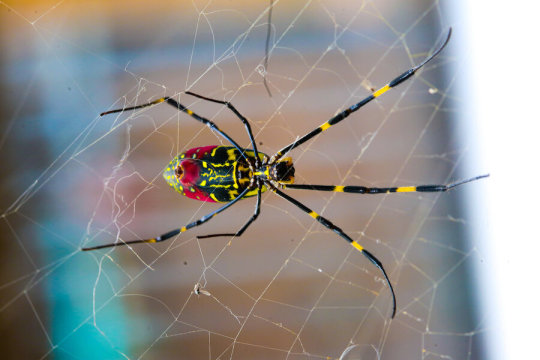
#flight rising#dragons#spiders#joro spider#orb weaver spider#trichonephila clavata#also yes this dragon is trans
2 notes
·
View notes
Text
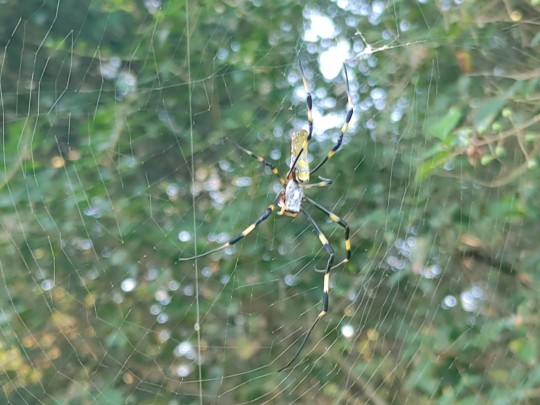

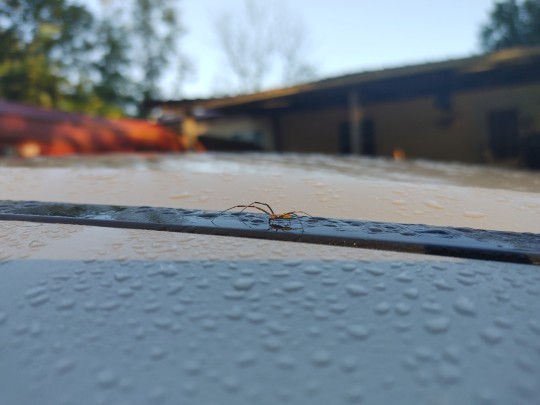
My favorite spider. Trichonephila Clavata. I photograph anytime I can
#spider#bug#arachnids#arachnid#cutie#meow#spooder#joro spider#Trichonephila Clavata#spiders#jorogumo#orb weaver#golden orb weaver#nature#animal#bugblr#bugs
2 notes
·
View notes
Note
Isnt there a type of spider that uses their webs to catch air currents in order to fly and travel long distances?
Is it a bird? Is it a plane? No, it's Emmet and uh oh the wind just turned. Help, he's over the lake now. There he goes. Goodbye Emmet.
That's the Joro Spider! I know because they're a recent invasive species here to the East Coast and they are verrry beautiful- They can make their silk golden colored!
I believe there's a few other spiders that can fly on their webs (Called Ballooning) but that's the one I know about because in addition to our normal massive amount of garden spiders and orb weavers we have in late Summer/Early Autumn, Joro Spiders have been showing up en masse... They're very beautiful.
Poor Ingo has to rescue his brother currently floating off over the lake; Though they can fly, swimming is another matter- Maybe that's how you befriend the poor waterlogged spider? Save him from his terrible fate, and he'll take you parasailing!
Spoilered: Image of a Joro Spider. They are large and verrry colorful!

Image desc: [An image of a Joro Spider sitting on a web. It's legs are long, thin, and black with yellow stripes. It's body is primarily vivid yellow with grey and black stripes and two large, bright red spots on the sides.]
#Seth.chitchat#Seth.anon#Seth.asks#Spiders#cw: spiders#I spoiler tagged it in case of spider fears#Drider discussion
14 notes
·
View notes
Note
So, there used to be a Joro spider living below my water tank.
I never named it. Every morning I'll look out and see if it's still there, the thing doesn't move much, I could just grab it if I had wanted to. But I left it be, not because it was an orb weaver and I don't like eating orb weavers, I just didn't feel like bothering this one.
It makes pretty yellow webs.
One night, after a particularly bad storm, the spider and its web disappeared.
I guess I should be glad about it because they reproduce pretty fast, it'll be bad for my garden and one can only eat so many spiders before they get sick of them.
Hello again to you too... :')
22 notes
·
View notes
Text
love looking into references to write a family hierarchy for Big Mama and IT HAD TO BE THAT HER YOKAI IS BASED OF ORB WEAVERS. SPECIFICALLY THE JORO SPIDER.
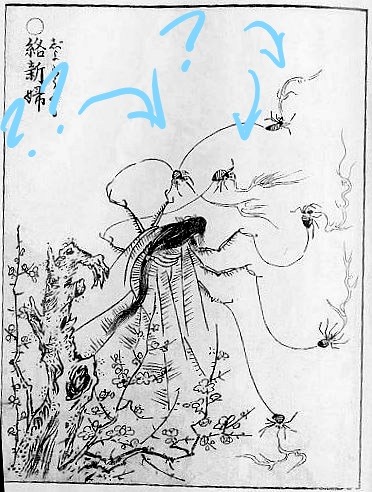
NEXT THING I KNOW IM GONNA HAVE TO LOOK INTO THE FUCKING FIRE BREATHING SPIDERS FROM THE FOLKLORE
#help me#if you dont know#look it up#arachniphobia#rottmnt big mama#big mama rottmnt#literally#what the hell#why fire breathing#SPIDERS??#aaaghhhh
4 notes
·
View notes
Text
You are meaning to tell me that I could go outside, find such an EXQUISITE orb weaver as a Joro spider, possibly within miles of my own Haven? Possibly even a breeding pair if I were lucky enough, simply by wandering the forest and searching for one?
6 notes
·
View notes
Text
What are Joro spiders? The invasive species spreading in the US
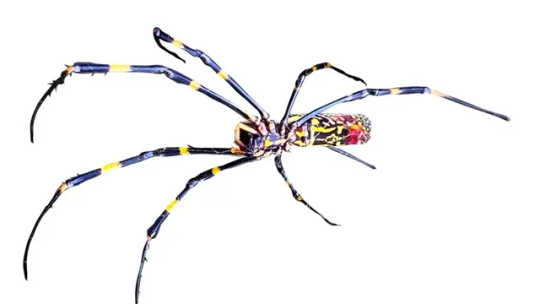
The Joro spiders are sometimes called “parachuting” spiders because they can move by shooting out a long strand of silk that gets caught in the wind and carries them through the air. What are Joro spiders? The Joro — trichonephila clavata — is part of a group of spiders known as “orb weavers” for their highly organized, wheel-shaped webs. Common in Japan, China, Korea and Taiwan, Joro females have colorful yellow, blue and red markings on their bodies. They can measure 3 inches across when their legs are fully extended. Giant, feral goldfish wreaking havoc in Great Lakes The Joro appears better suited to colder temperatures than a related species, researchers at the University of Georgia said in a paper published last year. Are Joro spiders dangerous? According to scientists, the Joro spider only poses a threat to the things that get caught in its web. This can include butterflies, cockroaches, stink bugs and wasps but not humans. “We have no evidence that they’ve done any damage to a person or a pet,” Clemson assistant professor Dave Coyle said.
More News
#current events#gaza#free gaza#i stand with palestine#free free palestine#genocide#tayvis#kc chiefs#kansas city chiefs#taylor and travis#jason kelce#brittany mahomes#super bowl lviii#patrick mahomes#baltimore ravens#nfl football#san fransisco 49ers#nfl#wade wilson#marvel comics#spider man#peter parker#spidey#marvel spiderman#khan younis#israeli army#free palestine#israel#hind#palestine
0 notes
Text
Spider Symbolism

September is for spiders. They always show up around this time of year, spinning their webs, catching their prey. And this year, we have two enormous orb weavers at the front door, and 3 joro spiders at the back door. Needless to say, we've been finding creative ways to get in and out of the house.
Read the full article
1 note
·
View note
Photo
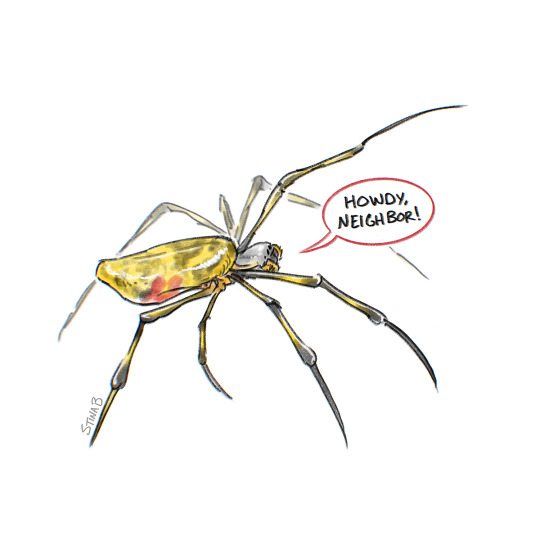
[Image: digital art of a spider, saying “Howdy, neighbor!” in a speech bubble. Its large abdomen is mostly yellow, with black and red markings, and its long legs are black with yellow stripes. One foreleg is lifted as if waving. End ID]
You may have seen some alarming headlines about giant venomous parachuting spiders invading the US and colonizing the east coast. While some of those things are technically correct, the phrasing is often sensationalist and misleading.
Jorō spiders (Trichonephila clavata) originated in East Asia and have been present in the southeast US for around a decade, predominately in Georgia.
Female Jorōs can reach an inch in body-length and are bright yellow, while males are smaller and brown. One of their close relatives, Golden silk orb-weavers (Trichonephila clavipes), are native to the Americas and are similar in size. The baby spiders are the ones who do the “ballooning” (releasing silk so they can be dispersed by wind), a fairly common behavior among spiders.
The venom these spiders produce is medically insignificant for humans. They're unlikely to bite in the first place, and aren’t always able to break human skin even if they try.
Recent studies indicate that Jorōs can survive in regions colder than where they’re currently established. So, it’s possible that populations will begin expanding northwards in the next several years. However not every non-native species is “invasive,” and the ecological impact of these spiders is currently unclear.
If you find a Jorō spider, take a moment to admire them! Even if they’re sometimes a nuisance or are eventually determined to be invasive, that doesn’t mean they’re evil. They're just little creatures, weaving their webs, munching on bugs, and looking great while doing it.
Sources:
Jorō Spiders | PennState Extension (2022)
New spiders in north Georgia are hard to miss but pose no threat | UGA Cooperative Extension (2018)
No, you don't need to worry about joro spiders. They may even be helpful in some ways | NPR (2022)
26 notes
·
View notes
Note
I don’t know if you answer questions like this but how environmentally destructive are the invasive joro spiders in the United States? I like them but I think they’re out-competing our native orb weavers.
I forget who the quote was from, but someone (state official? wildlife department rep? entomologist?) in Georgia said as far as invasive species go, the Joro spider is "not so bad." Scientists have not noticed a big impact on native species yet. But...only time will tell.
52 notes
·
View notes
Text
Did you guys hear about this?
Excuse the clickbaity title but, the Joro spider, native to Korea, Taiwan, and China, could soon be coming to an American east coast city near (or far away from, i dont know where you live) you!
I live in Boston and everyone has been posting about this babe all day. Kinda excited to meet her, as i love the yellow orb weavers we already have around here.
23 notes
·
View notes
Photo

Photo by Fran Perler
Nephila clavata, Golden Orb-Weaver, ジョロウグモ (Joro-gumo)
4 notes
·
View notes
Text
silkandspear replied to your post: “I found a Giant Gold Orb Weaver a little ways...
“If you have the chance, would you tell her she’s welcome to stay with me for the winter?”

“Oh I didn’t mean like...she’d hibernate or actually go away I meant...you know, their life cycles end in mid-fall. I don’t think she’s a youkai but I’ll mention next time I’m out there. I’ll tell the Joro too, since you’re a jorogumo I’m sure you’ll get along with her just fine too.”
3 notes
·
View notes
Text
I've seen so many joro/banana/golden orb weaver spiders this year and I'm so sad to see them go :'(
#there's one left in my backyard and she's somehow been powering through the chillier nights#out of feathers.#i also had a regular garden spider and two orchard orb weavers!#spiders mention
0 notes
Photo

New Post has been published on https://techcrunchapp.com/like-it-or-not-joro-spiders-are-here-to-stay-national-news/
Like it or not, Joro spiders are here to stay | National News

ATLANTA — Chances are, if you live in northeast Georgia you’ve come across an East Asian Joro spider this fall.
At almost 3 inches across when their legs are fully extended, they’re hard to miss. While they’re roughly the same size as banana spiders and yellow garden spiders, the distinctive yellow and blue-black stripes on their backs and bright red markings on their undersides are unique. Their enormous three-dimensional webs are a striking golden color and tend to be located higher off the ground than those of other spiders.
“We’ve been getting lots of calls and emails from people reporting sightings,” Byron Freeman, director of the Georgia Museum of Natural History, said. “They seem to be really common in riparian areas and in urban areas around people’s houses, but they’re also in the deep woods.”
Joro spiders have spread widely in Georgia since they were first spotted in Hoschton in 2013. They probably arrived by hitching a ride in a shipping container from China or Japan, according to Freeman. He and Richard Hoebeke, associate curator of the museum’s arthropod collection and a research professional in the University of Georgia College of Agricultural and Environmental Sciences Department of Entomology, confirmed the identity of those early arrivals based on genetic analysis in 2015.
Now, five years later, Joro spiders appear to have successfully established themselves in the area, with recent confirmed reports from as far afield as Blairsville and Greenville, S.C. But there is still much that remains unknown about them.
One important question is how they might affect the local ecosystem. Will they outcompete other orb weaving spiders? Will they reduce insect populations through predation?
“We don’t know what the impact is going to be,” Freeman, a faculty member in the University of Georgia Odum School of Ecology, said. “Right now, we’re trying to learn as much as we can about them.”
So far, early observations indicate that Joros are coexisting with the area’s other orb weaving spiders, with webs close to, and in some cases even attached to, one another.
And Joro spiders also appear to be able to capture and feed on at least one insect that other local spiders are not: adult brown marmorated stink bugs, an invasive pest that can infest houses and damage crops. In turn, Joro spiders are vulnerable to predators like mud dauber wasps and birds.
Freeman noted that dewdrop spiders, a kleptoparasite — as the name implies, they steal food from others — have been spotted in Joro webs.
“They may be switching from what we thought was their principal host, the banana spider, to this new kind of orb weaver,” he said. He pointed out that banana spiders, a relative of the Joro, are native to the Caribbean and Central America. They were first recorded in the U.S. in 1862 and have since naturalized.
“My guess is that this will be no different than the banana spider, and I don’t know that we can assess what the effect of the banana spider has been at this point,” he said.
Another question Freeman says he hopes to answer is how the males find their mates.
Joro spiders travel by ballooning, letting the wind carry them on a strand of gossamer.
“The male has to drift in and find the female,” Freeman said. “Sometimes there’ll be four or five males on a web, sometimes there’ll be one, so the males are moving between webs. When you have a large population it seems feasible that a male could just drift from one spot to the next, but when you don’t have a lot of webs around, how does the male show up?”
Freeman is also conducting further genetic analysis to determine what causes some Joro spiders to have a different color pattern. While most have distinctive black and yellow striped legs, some have legs that are solid black. These black morphs have other physical differences that are only apparent when viewed under a microscope, and Freeman has determined that they are genetically distinct members of the species.
Despite their size, Freeman said that Joro spiders don’t pose a threat to people.
“All spiders have venom that they use to subdue prey,” he said. “If you put your hand in front of one and try to make it bite you, it probably will. But they run if you disturb their web. They’re trying to get out of the way.”
Freeman said that Joros can be shooed away with a broom if they’re in a location that puts them too close for comfort.
But as for removing them permanently, he compared such efforts to shoveling sand at the beach.
“Should you try to get rid of them?” said Freeman. “You can, but at this point, they’re here to stay.”
If you spot a Joro spider — especially if you can provide a photo tagged with date and location — contact Hoebeke at [email protected].
Beth Gavrilles is the public relations coordinator for the University of Georgia Odum School of Ecology.
(function(d, s, id) var js, fjs = d.getElementsByTagName(s)[0]; if (d.getElementById(id)) return; js = d.createElement(s); js.id = id; js.src = "https://connect.facebook.net/en_US/sdk.js#xfbml=1&version=v2.5&appId=1076755405678815"; fjs.parentNode.insertBefore(js, fjs); (document, 'script', 'facebook-jssdk'));
0 notes